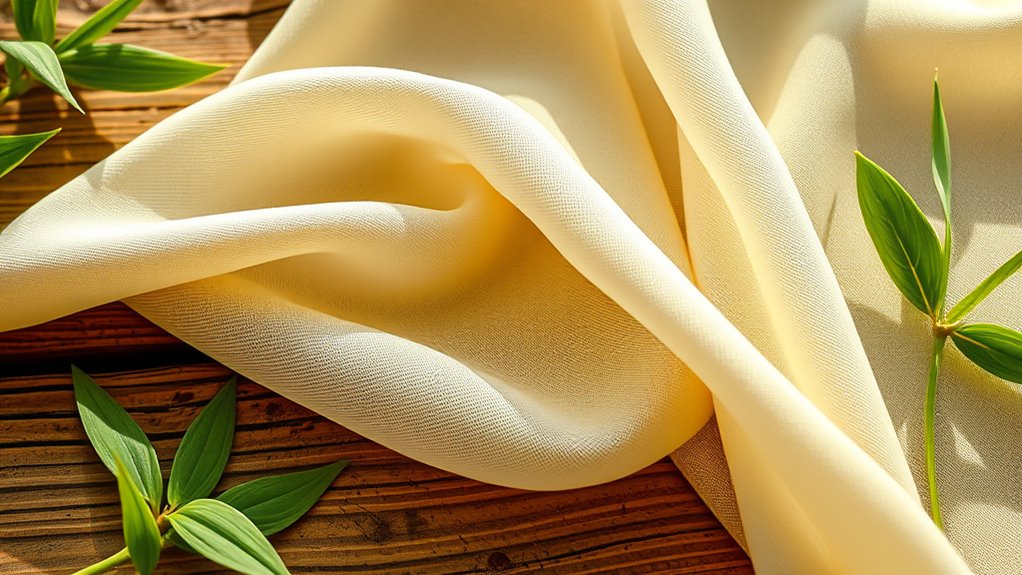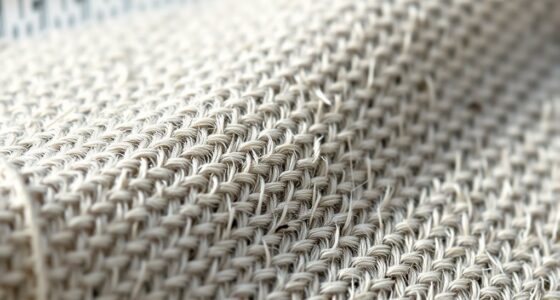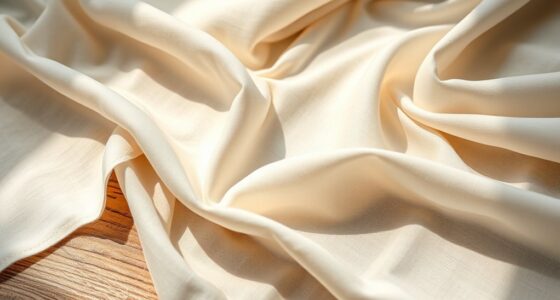Bamboo rayon is known for its incredible softness, offering a luxurious feel against your skin, while also being an eco-friendly fabric when produced responsibly. It’s made through a chemical process that transforms bamboo pulp into a breathable, sustainable textile, often using water recycling and non-toxic chemicals. With proper care, like washing in cold water and air drying, bamboo rayon remains durable and soft. To discover more about making the most of this eco-conscious fabric, keep exploring these key points.
Key Takeaways
- Bamboo rayon is a soft, breathable fabric made through chemical processes from bamboo pulp, offering luxurious comfort.
- Its eco-friendliness depends on sustainable manufacturing practices, including water recycling and non-toxic chemical use.
- Proper care involves washing in cold water, avoiding harsh chemicals, and air drying to maintain fabric softness and longevity.
- Although processed chemically, bamboo rayon can be biodegradable and environmentally sustainable when produced responsibly.
- Durability varies based on manufacturing quality and care, making proper maintenance essential for lasting softness and strength.

Have you ever wondered what bamboo rayon really is and how it differs from other fabrics? When you hear about bamboo rayon, you might think of a soft, luxurious textile, but it’s also important to understand how it’s made and what sets it apart. Bamboo rayon is produced through a process that involves transforming bamboo pulp into a fabric, often through a method called viscose process. This process can be eco friendly if manufacturers prioritize sustainable practices, utilizing non-toxic chemicals and recycling water. By choosing bamboo rayon manufactured with eco friendly methods, you’re supporting a fiber that aims to reduce environmental impact compared to traditional textiles. This focus on sustainable manufacturing is crucial because it minimizes harmful emissions and conserves resources.
Bamboo rayon is a sustainable, eco-friendly fabric made through chemical processes that transform bamboo pulp into soft, durable textiles.
In terms of textile durability, bamboo rayon tends to strike a good balance. It’s soft, breathable, and comfortable against your skin, but it also maintains a decent level of resilience. While it isn’t as tough as some synthetic fibers, with proper care, bamboo rayon can last quite a while, making it a practical choice for everyday wear. One reason for this durability is that bamboo fibers, once processed into rayon, retain some of the natural strength from the plant. However, because the manufacturing process involves chemical treatments, the fiber can sometimes be more delicate than other natural fabrics like cotton or linen. That’s why it’s essential to follow care instructions carefully—washing in cold water, avoiding harsh chemicals, and air drying can help extend its lifespan. Additionally, understanding mindfulness in fabric care can help you make better decisions to prolong the life of your garments.
Another point to keep in mind is that the eco friendly manufacturing process doesn’t just affect the environment—it can also influence the textile’s longevity. When chemicals are used responsibly and water is recycled during production, the resulting fabric often has fewer residual chemicals that could weaken the fibers over time. This means that well-made bamboo rayon can maintain its softness and appearance longer, providing good value for your investment. Plus, since it’s biodegradable, bamboo rayon is a more sustainable choice overall, especially if you’re conscious of your ecological footprint.
Ultimately, understanding bamboo rayon involves recognizing its potential for eco friendly manufacturing and appreciating its textile robustness. It’s a fabric that combines sustainability with comfort, but like any material, its quality depends on how it’s produced and cared for. When you pick bamboo rayon made with eco consciousness, you’re supporting a more sustainable textile industry. And by caring for it properly, you can enjoy its softness and durability for years to come.
Frequently Asked Questions
Is Bamboo Rayon Safe for Sensitive Skin?
Yes, bamboo rayon is generally safe for sensitive skin because it has hypoallergenic properties that help reduce skin irritation. You might find it gentle and soft, making it a good choice for those prone to allergies or irritation. However, it’s always wise to check for any specific sensitivities you may have. When cared for properly, bamboo rayon can provide a comfortable, irritation-free experience for sensitive skin types.
How Does Bamboo Rayon Compare to Cotton in Durability?
Bamboo rayon generally isn’t as durable as cotton, especially in fabric longevity and tear resistance. While bamboo rayon offers a softer feel, it tends to weaken faster with washing and wear. Cotton, on the other hand, stands up better over time, maintaining its strength longer. If you’re looking for a fabric that lasts and resists tears, cotton’s the smarter choice, but bamboo rayon provides a luxurious softness that’s hard to beat.
Can Bamboo Rayon Be Blended With Other Fabrics?
Yes, you can blend bamboo rayon with other fabrics. Fabric blending enhances textile versatility, allowing you to create garments with unique properties. When you blend bamboo rayon with materials like cotton, polyester, or spandex, it improves durability, stretch, and feel. This versatility makes bamboo rayon suitable for various applications, from casual wear to activewear. Just guarantee proper care instructions for the blended fabrics to maintain their quality over time.
What Are the Environmental Impacts of Bamboo Rayon Production?
Think of bamboo rayon’s environmental footprint as a delicate dance. While it’s softer and more sustainable than many fabrics, its production can involve chemicals that harm ecosystems if unchecked. You can reduce impact by choosing brands committed to sustainable practices, such as eco-friendly processing methods. By doing so, you support a more eco-conscious industry, ensuring bamboo rayon remains a greener choice for your wardrobe.
How Should Bamboo Rayon Be Stored to Maintain Quality?
To keep your bamboo rayon fabric in top condition, follow these storage tips: store it in a cool, dry place away from direct sunlight, which can fade the color. Fold it neatly to prevent wrinkles and damage. For fabric maintenance, avoid hanging it for long periods, as this can cause stretching. Keep it separate from rough fabrics to prevent snags, ensuring your bamboo rayon stays soft and vibrant over time.
Conclusion
Now that you know all about bamboo rayon, get ready to indulge in the softest, most sustainable fabric the world has ever seen. It’s like wrapping yourself in clouds made of eco-friendly magic—so gentle, so breathable, you’ll swear it’s spun from a dream. Once you experience its silky touch, you’ll never settle for anything less. Bamboo rayon isn’t just fabric; it’s a revolution in comfort and sustainability—prepare to be utterly transformed!









